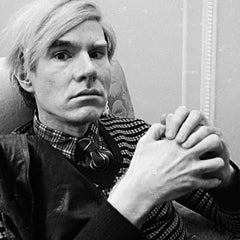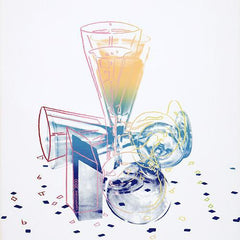Andy Warhol Prints for Sale
Andy Warhol (1928-1987) was a successful magazine and illustrator who became a leading artist of the 1960s Pop art movement. He ventured into a wide variety of art forms, including performance art, filmmaking, video installations and writing, and controversially blurred the lines between fine art and mainstream aesthetics.
Born Andrew Warhola in Pittsburgh, Pennsylvania, Warhol's parents were Slovakian immigrants. His father, Andrej Warhola, was a construction worker, while his mother, Julia Warhola, was an embroiderer. They were devout Byzantine Catholics who attended mass regularly and maintained much of their Slovakian culture and heritage while living in one of Pittsburgh's Eastern European ethnic enclaves.
At the age of eight, Warhol contracted Chorea — also known as St. Vitus's Dance — a rare and sometimes fatal disease of the nervous system that left him bedridden for several months. It was during these months, while Warhol was sick in bed, that his mother, herself a skillful artist, gave him his first drawing lessons. Drawing soon became Warhol's favorite childhood pastime. He was also an avid fan of the movies, and when his mother bought him a camera at the age of nine, he took up photography as well, developing film in a makeshift darkroom he set up in their basement.
Warhol attended Holmes Elementary school and took the free art classes offered at the Carnegie Institute (now the Carnegie Museum of Art) in Pittsburgh. In 1942, at the age of 14, Warhol again suffered a tragedy when his father passed away from a jaundiced liver. Warhol was so upset that he could not attend his father's funeral, and he hid under his bed throughout the wake. Warhol's father had recognized his son's artistic talents, and in his will he dictated that his life savings go toward Warhol's college education. That same year, Warhol began at Schenley High School, and upon graduating, in 1945, he enrolled at the Carnegie Institute for Technology (now Carnegie Mellon University) to study pictorial design.
When he graduated from college with his Bachelor of Fine Arts degree in 1949, Warhol moved to New York City to pursue a career as a commercial artist. It was also at this time that he dropped the "a" at the end of his last name to become Andy Warhol. He landed a job with Glamour magazine in September, and went on to become one of the most successful commercial artists of the 1950s. He won frequent awards for his uniquely whimsical style, using his own blotted line technique and rubber stamps to create his drawings.
In the late 1950s, Warhol began devoting more attention to painting, and in 1961, he debuted the concept of 'pop art' — paintings that focused on mass-produced commercial goods. In 1962, he exhibited the now-iconic paintings of Campbell's soup cans. These small canvas works of everyday consumer products created a major stir in the art world, bringing both Warhol and pop art into the national spotlight for the first time.
He also painted celebrity portraits in vivid and garish colors; his most famous subjects include Marilyn Monroe, Elizabeth Taylor, Mick Jagger and Mao Tse-tung. As these portraits gained fame and notoriety, Warhol began to receive hundreds of commissions for portraits from socialites and celebrities.
In 1964, Warhol opened his own art studio, a large silver-painted warehouse known simply as The Factory. The Factory quickly became one of New York City's premier cultural hotspots, a scene of lavish parties attended by the city's wealthiest socialites and celebrities, including musician Lou Reed, who paid tribute to the hustlers and transvestites he'd met at The Factory with his hit song Walk on the Wild Side — the verses of which contain descriptions of individuals who were fixtures at the legendary studio/warehouse in the 1960s.
In 1968, Warhol's thriving career almost ended. He was shot by Valerie Solanas, an aspiring writer and radical feminist Warhol was seriously wounded in this attack. Solanas had appeared in one of Warhol's films and was reportedly upset with him over his refusal to use a script she had written. After the shooting, Solanas was arrested and later pleaded guilty to the crime. Warhol spent weeks in a New York hospital recovering from his injuries and underwent several subsequent surgeries. As a result of the injuries he sustained, he had to wear a surgical corset for the rest of his life.
In the 1970s, Warhol continued to explore other forms of media. He published such books as The Philosophy of Andy Warhol (From A to B and Back Again) and Exposures. Warhol also experimented extensively with video art, producing more than 60 films during his career. Some of his most famous films include Sleep, which depicts poet John Giorno sleeping for six hours, and Eat, which shows a man eating a mushroom for 45 minutes.
Warhol also worked in sculpture and photography, and in the 1980s, he moved into television, hosting Andy Warhol's TV and Andy Warhol's Fifteen Minutes on MTV.
Death
In his later life, Warhol suffered from chronic issues with his gallbladder. On February 20, 1987, he was admitted to New York Hospital where his gallbladder was successfully removed and he seemed to be recovering. However, days later he suffered complications that resulted in sudden cardiac arrest and he died on February 22, 1987, at the age of 58. Thousands of people attended a memorial for the artist at St. Patrick's Cathedral in New York City.
Biography from Biography.com
Born Andrew Warhola in Pittsburgh, Pennsylvania, Warhol's parents were Slovakian immigrants. His father, Andrej Warhola, was a construction worker, while his mother, Julia Warhola, was an embroiderer. They were devout Byzantine Catholics who attended mass regularly and maintained much of their Slovakian culture and heritage while living in one of Pittsburgh's Eastern European ethnic enclaves.
At the age of eight, Warhol contracted Chorea — also known as St. Vitus's Dance — a rare and sometimes fatal disease of the nervous system that left him bedridden for several months. It was during these months, while Warhol was sick in bed, that his mother, herself a skillful artist, gave him his first drawing lessons. Drawing soon became Warhol's favorite childhood pastime. He was also an avid fan of the movies, and when his mother bought him a camera at the age of nine, he took up photography as well, developing film in a makeshift darkroom he set up in their basement.
Warhol attended Holmes Elementary school and took the free art classes offered at the Carnegie Institute (now the Carnegie Museum of Art) in Pittsburgh. In 1942, at the age of 14, Warhol again suffered a tragedy when his father passed away from a jaundiced liver. Warhol was so upset that he could not attend his father's funeral, and he hid under his bed throughout the wake. Warhol's father had recognized his son's artistic talents, and in his will he dictated that his life savings go toward Warhol's college education. That same year, Warhol began at Schenley High School, and upon graduating, in 1945, he enrolled at the Carnegie Institute for Technology (now Carnegie Mellon University) to study pictorial design.
When he graduated from college with his Bachelor of Fine Arts degree in 1949, Warhol moved to New York City to pursue a career as a commercial artist. It was also at this time that he dropped the "a" at the end of his last name to become Andy Warhol. He landed a job with Glamour magazine in September, and went on to become one of the most successful commercial artists of the 1950s. He won frequent awards for his uniquely whimsical style, using his own blotted line technique and rubber stamps to create his drawings.
In the late 1950s, Warhol began devoting more attention to painting, and in 1961, he debuted the concept of 'pop art' — paintings that focused on mass-produced commercial goods. In 1962, he exhibited the now-iconic paintings of Campbell's soup cans. These small canvas works of everyday consumer products created a major stir in the art world, bringing both Warhol and pop art into the national spotlight for the first time.
He also painted celebrity portraits in vivid and garish colors; his most famous subjects include Marilyn Monroe, Elizabeth Taylor, Mick Jagger and Mao Tse-tung. As these portraits gained fame and notoriety, Warhol began to receive hundreds of commissions for portraits from socialites and celebrities.
In 1964, Warhol opened his own art studio, a large silver-painted warehouse known simply as The Factory. The Factory quickly became one of New York City's premier cultural hotspots, a scene of lavish parties attended by the city's wealthiest socialites and celebrities, including musician Lou Reed, who paid tribute to the hustlers and transvestites he'd met at The Factory with his hit song Walk on the Wild Side — the verses of which contain descriptions of individuals who were fixtures at the legendary studio/warehouse in the 1960s.
In 1968, Warhol's thriving career almost ended. He was shot by Valerie Solanas, an aspiring writer and radical feminist Warhol was seriously wounded in this attack. Solanas had appeared in one of Warhol's films and was reportedly upset with him over his refusal to use a script she had written. After the shooting, Solanas was arrested and later pleaded guilty to the crime. Warhol spent weeks in a New York hospital recovering from his injuries and underwent several subsequent surgeries. As a result of the injuries he sustained, he had to wear a surgical corset for the rest of his life.
In the 1970s, Warhol continued to explore other forms of media. He published such books as The Philosophy of Andy Warhol (From A to B and Back Again) and Exposures. Warhol also experimented extensively with video art, producing more than 60 films during his career. Some of his most famous films include Sleep, which depicts poet John Giorno sleeping for six hours, and Eat, which shows a man eating a mushroom for 45 minutes.
Warhol also worked in sculpture and photography, and in the 1980s, he moved into television, hosting Andy Warhol's TV and Andy Warhol's Fifteen Minutes on MTV.
Death
In his later life, Warhol suffered from chronic issues with his gallbladder. On February 20, 1987, he was admitted to New York Hospital where his gallbladder was successfully removed and he seemed to be recovering. However, days later he suffered complications that resulted in sudden cardiac arrest and he died on February 22, 1987, at the age of 58. Thousands of people attended a memorial for the artist at St. Patrick's Cathedral in New York City.
Biography from Biography.com



